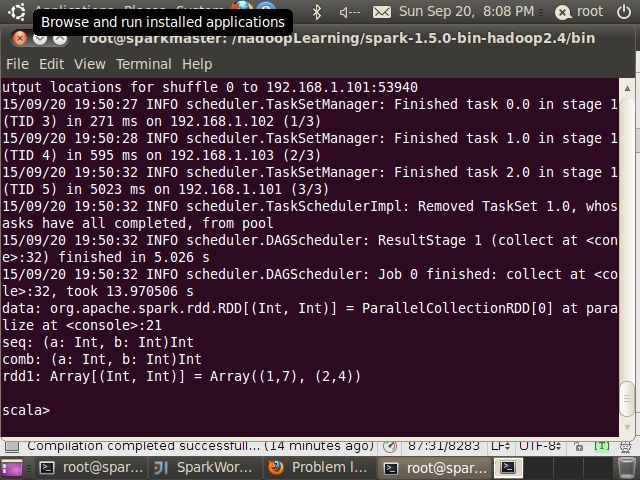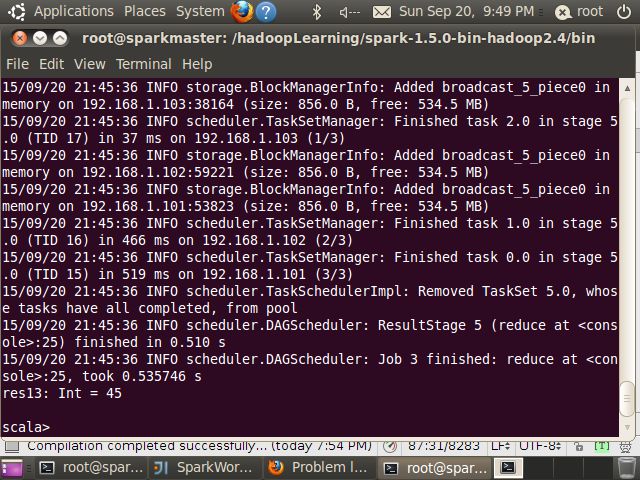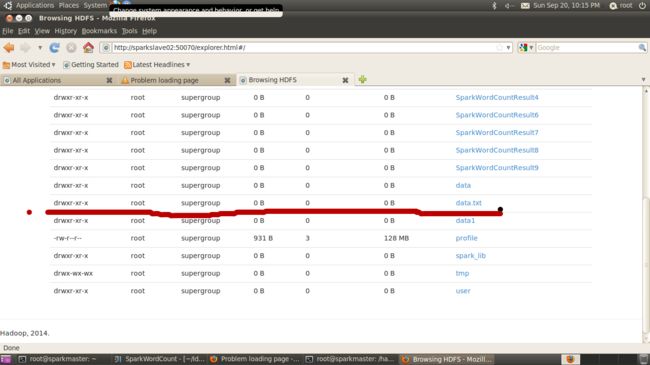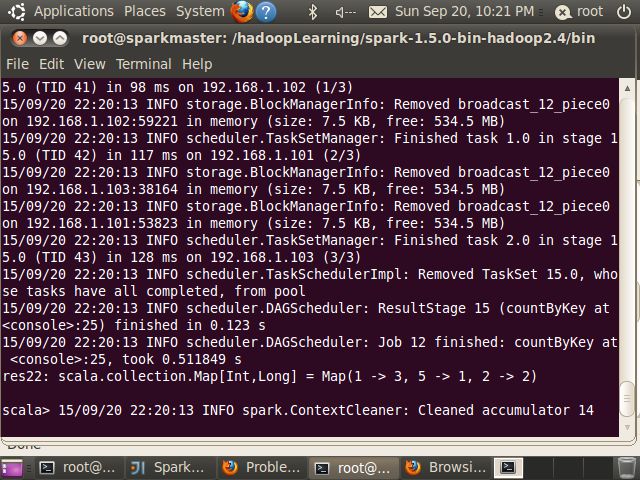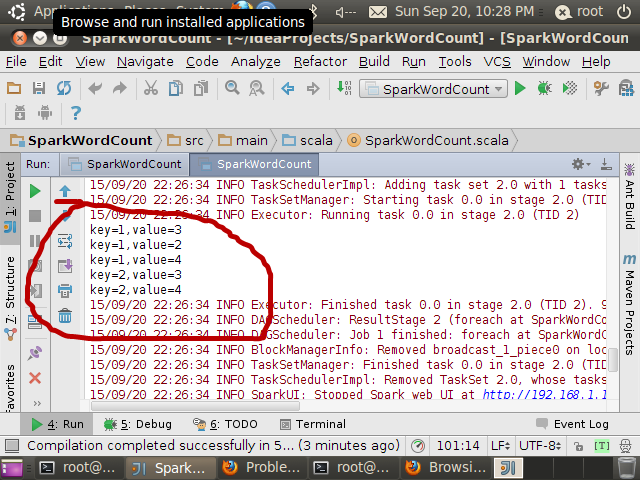Spark修炼之道(进阶篇)——Spark入门到精通:第六节 Spark编程模型(三)
作者:周志湖
网名:摇摆少年梦
微信号:zhouzhihubeyond
本节主要内容
- RDD transformation(续)
- RDD actions
1. RDD transformation(续)
(1)repartitionAndSortWithinPartitions(partitioner)
repartitionAndSortWithinPartitions函数是repartition函数的变种,与repartition函数不同的是,repartitionAndSortWithinPartitions在给定的partitioner内部进行排序,性能比repartition要高。
函数定义:
/**
* Repartition the RDD according to the given partitioner and, within each resulting partition,
* sort records by their keys.
*
* This is more efficient than calling repartition and then sorting within each partition
* because it can push the sorting down into the shuffle machinery.
*/
def repartitionAndSortWithinPartitions(partitioner: Partitioner): RDD[(K, V)]
使用示例:
scala> val data = sc.parallelize(List((1,3),(1,2),(5,4),(1, 4),(2,3),(2,4)),3)
data: org.apache.spark.rdd.RDD[(Int, Int)] = ParallelCollectionRDD[3] at parallelize at <console>:21
scala> data.repartitionAndSortWithinPartitions(new HashPartitioner(3)).collect
res3: Array[(Int, Int)] = Array((1,4), (1,3), (1,2), (2,3), (2,4), (5,4))(2)aggregateByKey(zeroValue)(seqOp, combOp, [numTasks])
aggregateByKey函数对PairRDD中相同Key的值进行聚合操作,在聚合过程中同样使用了一个中立的初始值。其函数定义如下:
/**
* Aggregate the values of each key, using given combine functions and a neutral “zero value”.
* This function can return a different result type, U, than the type of the values in this RDD,
* V. Thus, we need one operation for merging a V into a U and one operation for merging two U’s,
* as in scala.TraversableOnce. The former operation is used for merging values within a
* partition, and the latter is used for merging values between partitions. To avoid memory
* allocation, both of these functions are allowed to modify and return their first argument
* instead of creating a new U.
*/
def aggregateByKey[U: ClassTag](zeroValue: U)(seqOp: (U, V) => U,
combOp: (U, U) => U): RDD[(K, U)]
示例代码:
import org.apache.spark.SparkContext._
import org.apache.spark.{SparkConf, SparkContext}
object SparkWordCount{
def main(args: Array[String]) {
if (args.length == 0) {
System.err.println("Usage: SparkWordCount <inputfile> <outputfile>")
System.exit(1)
}
val conf = new SparkConf().setAppName("SparkWordCount").setMaster("local")
val sc = new SparkContext(conf)
val data = sc.parallelize(List((1,3),(1,2),(1, 4),(2,3),(2,4)))
def seqOp(a:Int, b:Int) : Int ={
println("seq: " + a + "\t " + b)
math.max(a,b)
}
def combineOp(a:Int, b:Int) : Int ={
println("comb: " + a + "\t " + b)
a + b
}
val localIterator=data.aggregateByKey(1)(seqOp, combineOp).toLocalIterator
for(i<-localIterator) println(i)
sc.stop()
}
}执行结果:
seq: 1 3
seq: 3 2
seq: 3 4
seq: 1 3
seq: 3 4
(1,4)
(2,4)
从输出结果来看,seqOp函数起作用了,但comineOp函数并没有起作用,在Spark 1.5、1.4及1.3三个版本中测试,结果都是一样的。这篇文章http://www.iteblog.com/archives/1261给出了aggregateByKey的使用,其Spark版本是1.1,其返回结果符合预期。个人觉得是版本原因造成的,具体后面有时间再来分析。
RDD中还有其它非常有用的transformation操作,参见API文档:http://spark.apache.org/docs/latest/api/scala/index.html
2. RDD actions
本小节将介绍常用的action操作,前面使用的collect方法便是一种action,它返回RDD中所有的数据元素,方法定义如下:
/**
* Return an array that contains all of the elements in this RDD.
*/
def collect(): Array[T]
(1) reduce(func)
reduce采样累加或关联操作减少RDD中元素的数量,其方法定义如下:
/**
* Reduces the elements of this RDD using the specified commutative and
* associative binary operator.
*/
def reduce(f: (T, T) => T): T
使用示例:
scala> val data=sc.parallelize(1 to 9)
data: org.apache.spark.rdd.RDD[Int] = ParallelCollectionRDD[6] at parallelize at <console>:22
scala> data.reduce((x,y)=>x+y)
res12: Int = 45
scala> data.reduce(_+_)
res13: Int = 45(2)count()
/**
* Return the number of elements in the RDD.
*/
def count(): Long
使用示例:
scala> val data=sc.parallelize(1 to 9)
data: org.apache.spark.rdd.RDD[Int] = ParallelCollectionRDD[6] at parallelize at <console>:22
scala> data.count
res14: Long = 9
(3)first()
/**
* Return the first element in this RDD.
*/
def first()
scala> val data=sc.parallelize(1 to 9)
data: org.apache.spark.rdd.RDD[Int] = ParallelCollectionRDD[6] at parallelize at <console>:22
scala> data.first
res15: Int = 1
(4)take(n)
/**
* Take the first num elements of the RDD. It works by first scanning one partition, and use the
* results from that partition to estimate the number of additional partitions needed to satisfy
* the limit.
*
* @note due to complications in the internal implementation, this method will raise
* an exception if called on an RDD of Nothing or Null.
*/
def take(num: Int): Array[T]
scala> val data=sc.parallelize(1 to 9)
data: org.apache.spark.rdd.RDD[Int] = ParallelCollectionRDD[6] at parallelize at <console>:22
scala> data.take(2)
res16: Array[Int] = Array(1, 2)
(5) takeSample(withReplacement, num, [seed])
对RDD中的数据进行采样
/**
* Return a fixed-size sampled subset of this RDD in an array
*
* @param withReplacement whether sampling is done with replacement
* @param num size of the returned sample
* @param seed seed for the random number generator
* @return sample of specified size in an array
*/
// TODO: rewrite this without return statements so we can wrap it in a scope
def takeSample(
withReplacement: Boolean,
num: Int,
seed: Long = Utils.random.nextLong): Array[T]
scala> val data=sc.parallelize(1 to 9)
data: org.apache.spark.rdd.RDD[Int] = ParallelCollectionRDD[6] at parallelize at <console>:22
scala> data.takeSample(false,5)
res17: Array[Int] = Array(6, 7, 4, 1, 2)
scala> data.takeSample(true,5)
res18: Array[Int] = Array(3, 3, 8, 3, 8)
(6) takeOrdered(n, [ordering])
/**
* Returns the first k (smallest) elements from this RDD as defined by the specified
* implicit Ordering[T] and maintains the ordering. This does the opposite of [[top]].
* For example:
* {{{
* sc.parallelize(Seq(10, 4, 2, 12, 3)).takeOrdered(1)
* // returns Array(2)
*
* sc.parallelize(Seq(2, 3, 4, 5, 6)).takeOrdered(2)
* // returns Array(2, 3)
* }}}
*
* @param num k, the number of elements to return
* @param ord the implicit ordering for T
* @return an array of top elements
*/
def takeOrdered(num: Int)(implicit ord: Ordering[T]): Array[T]
(6) saveAsTextFile(path)
将RDD保存到文件,本地模式时保存在本地文件,集群模式指如果在Hadoop基础上则保存在HDFS上
/**
* Save this RDD as a text file, using string representations of elements.
*/
def saveAsTextFile(path: String): Unit
scala> data.saveAsTextFile("/data.txt")(7) countByKey()
将RDD中的数据按Key计数
/**
* Count the number of elements for each key, collecting the results to a local Map.
*
* Note that this method should only be used if the resulting map is expected to be small, as
* the whole thing is loaded into the driver’s memory.
* To handle very large results, consider using rdd.mapValues(_ => 1L).reduceByKey(_ + _), which
* returns an RDD[T, Long] instead of a map.
*/
def countByKey(): Map[K, Long]
使用示例:
scala> val data = sc.parallelize(List((1,3),(1,2),(5,4),(1, 4),(2,3),(2,4)),3)
data: org.apache.spark.rdd.RDD[(Int, Int)] = ParallelCollectionRDD[10] at parallelize at <console>:22
scala> data.countByKey()
res22: scala.collection.Map[Int,Long] = Map(1 -> 3, 5 -> 1, 2 -> 2)
(8)foreach(func)
foreach方法遍历RDD中所有的元素
// Actions (launch a job to return a value to the user program)
/**
* Applies a function f to all elements of this RDD.
*/
def foreach(f: T => Unit): Unit
import org.apache.spark.SparkContext._
import org.apache.spark.{SparkConf, SparkContext}
object ForEachDemo{
def main(args: Array[String]) {
if (args.length == 0) {
System.err.println("Usage: SparkWordCount <inputfile> <outputfile>")
System.exit(1)
}
val conf = new SparkConf().setAppName("SparkWordCount").setMaster("local")
val sc = new SparkContext(conf)
val data = sc.parallelize(List((1,3),(1,2),(1, 4),(2,3),(2,4)))
data.foreach(x=>println("key="+x._1+",value="+x._2))
sc.stop()
}
}Sparkh中还存在其它非常有用的action操作,如foldByKey、sampleByKey等,参见API文档:http://spark.apache.org/docs/latest/api/scala/index.html

